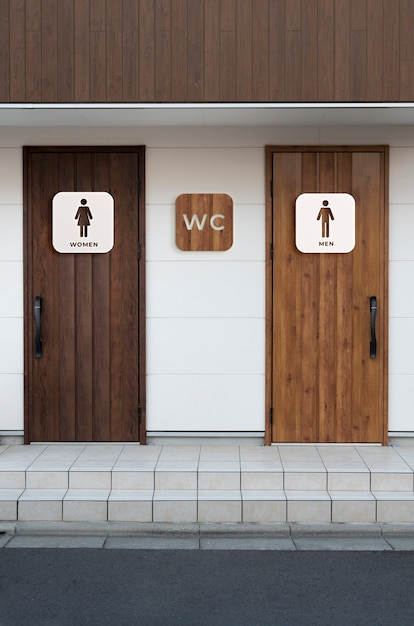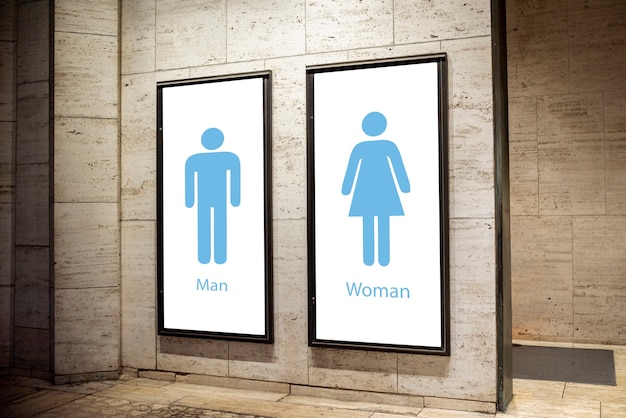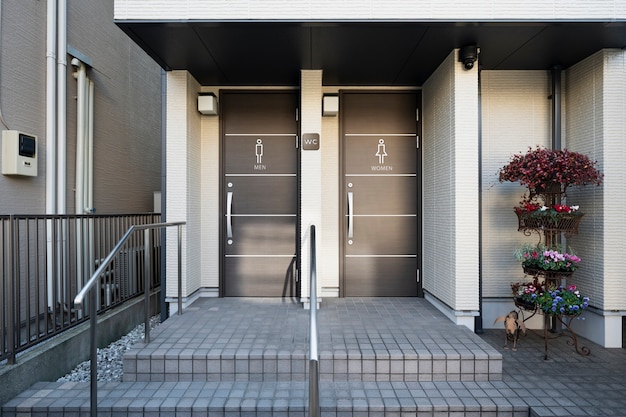Have you ever wondered why the doors in public toilets don’t quite reach the floor? It’s a perplexing sight that many of us have encountered, sparking curiosity about the reasons behind this design choice. In this exploration of restroom architecture, we delve into the fascinating world of public toilet doors and unravel the mysteries that lie beneath the surface—literally. Join us as we uncover the “Reasons Why the Doors in Public Toilets Don’t Reach the Floor,” shedding light on the purposeful considerations and functional aspects that make this seemingly peculiar design a common sight in restrooms around the world. Let’s unlock the door to understanding and demystify the logic behind this unique feature.

Section 1: Privacy vs. Ventilation – Striking the Balance:
Public toilet doors are crafted with a delicate balance in mind—maintaining privacy while ensuring proper ventilation. The design, where the doors don’t reach the floor, serves a crucial purpose in achieving this equilibrium.
Privacy as the Primary Objective:
The foremost function of a restroom door is to provide privacy for its users. This is especially vital in public spaces where multiple individuals share the facilities simultaneously. The absence of a gap between the door and the floor ensures a private and enclosed space for individuals to attend to their needs without compromising their personal space.
Ventilation Matters:
While privacy is paramount, so is ventilation. Public restrooms are subject to constant use, and adequate ventilation is essential for maintaining a fresh and hygienic environment. A slight gap at the bottom of the door allows air circulation, preventing the buildup of unpleasant odors and promoting a more comfortable experience for users.
Compliance with Regulations:
In the world of architecture and construction, building codes and regulations play a significant role in dictating design elements. Many regulatory standards acknowledge the necessity of proper ventilation in public restrooms. The design choice of doors not reaching the floor aligns with these regulations, ensuring that the enclosed space is well-ventilated and complies with safety and health standards.
ADVERTISEMENT
Section 2: Hygiene Concerns:

Beyond the realms of privacy and ventilation, the design of public toilet doors with a gap at the bottom is deeply rooted in hygiene considerations. Let’s explore how this seemingly unassuming feature contributes to a cleaner and more sanitary restroom environment.
Facilitating Easy Cleaning:
Public restrooms endure frequent use, and cleanliness is of utmost importance. The gap at the bottom of toilet doors allows for easy and efficient cleaning. Janitorial staff can reach the floor beneath the door with mops and cleaning tools, ensuring that no corner is left unattended. This design choice minimizes the accumulation of dirt, debris, and germs, promoting a higher standard of cleanliness.
Reducing Bacterial Growth:
The gap also serves as a preventive measure against the growth of harmful bacteria. Moisture can accumulate in the enclosed spaces of restrooms, creating an environment conducive to bacterial proliferation. By allowing air circulation and easy cleaning access, the design minimizes the risk of mold and bacterial buildup, contributing to a more hygienic restroom experience.
Aesthetics and Perception:
From a visual perspective, a gap at the bottom of the door can create an illusion of cleanliness. Seeing a clear space beneath the door gives users the impression that the restroom is well-maintained and regularly cleaned. This not only influences the perception of cleanliness but also enhances the overall user experience.
ADVERTISEMENT
Section 3: Accessibility and Safety:

The design of public toilet doors not reaching the floor extends beyond privacy and hygiene—it also addresses concerns related to accessibility and safety. Let’s delve into how this specific design choice enhances accessibility for maintenance and ensures a safer environment for users.
Enhanced Accessibility for Maintenance:
Maintenance staff play a crucial role in ensuring the upkeep of public restrooms. The design of doors with a gap at the bottom provides accessibility for cleaning and maintenance purposes. Janitors can easily reach the floor area beneath the door, allowing for thorough cleaning and swift maintenance activities. This not only promotes a cleaner restroom but also streamlines the workflow for maintenance personnel.
Emergency Situations and Safety Considerations:
In the realm of safety, the design of toilet doors with a gap contributes to emergency preparedness. In the event of an emergency, whether medical or otherwise, the visibility provided by the gap can be crucial. It allows for quick assessments and responses, both from bystanders and emergency responders. This design choice aligns with safety regulations and considerations, prioritizing the well-being of restroom users.
ADVERTISEMENT
Section 4: Cost-Effective Design:

Beyond functionality, the choice of public toilet doors not reaching the floor is underpinned by practical considerations, including cost-effectiveness. Let’s explore how this design choice proves to be an economically viable option in the construction and maintenance of public restroom facilities.
Optimizing Material Usage:
The gap at the bottom of public toilet doors is often a deliberate design decision to optimize material usage. Doors that don’t extend to the floor require less material, resulting in cost savings during the manufacturing process. This proves particularly advantageous in projects where budget constraints are a significant factor.
Simplified Installation and Maintenance:
The simplicity of doors without a full-floor extension also translates into easier installation and maintenance. The streamlined design requires less intricate construction and is quicker to install. Additionally, when repairs or replacements are necessary, the process is often more straightforward, saving both time and money over the lifecycle of the restroom facility.
Long-Term Cost Efficiency:
While the upfront savings in material and installation costs are evident, the long-term cost efficiency of this design should not be overlooked. The ease of maintenance and reduced susceptibility to damage can result in lower ongoing operational costs. This makes the design choice not only cost-effective in the short term but also financially advantageous over the life of the restroom facility.
ADVERTISEMENT
Section 5: Common Misconceptions:

As we unravel the intricacies of public toilet door design, it’s crucial to address and dispel common misconceptions that surround this seemingly simple yet purposeful feature.
Misconception 1: Lack of Privacy:
One prevalent misconception is that doors not reaching the floor compromise privacy. However, as we’ve explored earlier, the primary function of these doors is to provide adequate privacy while balancing the need for ventilation. The intentional design ensures an enclosed and private space for users.
Misconception 2: Unhygienic Design:
Another misconception relates to hygiene concerns. Some may assume that the gap at the bottom of the door contributes to an unclean environment. On the contrary, this design choice facilitates easier cleaning, reducing the risk of bacterial growth and ensuring a more sanitary restroom space.
Misconception 3: Safety Compromised:
Concerns about safety are also occasionally raised, with some fearing that the gap may compromise security or emergency situations. However, as highlighted in the previous section, the design choice actually enhances visibility and accessibility, contributing to a safer environment.
Addressing Misconceptions:
It’s essential to debunk these misconceptions with factual information. The design of public toilet doors not reaching the floor is a thoughtful and purposeful choice, carefully balancing various factors to create a restroom environment that prioritizes privacy, hygiene, accessibility, and cost-effectiveness.
Conclusion:

In the journey of unraveling the mysteries behind the design of public toilet doors, we’ve explored the multifaceted reasons why these doors don’t quite reach the floor. Far from being a mere architectural quirk, this intentional design choice serves a myriad of purposes that collectively contribute to a more functional and efficient restroom environment.
ADVERTISEMENT
From prioritizing privacy while ensuring ventilation to addressing hygiene concerns and enhancing accessibility, the gap at the bottom of public toilet doors is a carefully calculated feature. It optimizes material usage, simplifies installation and maintenance, and even plays a role in emergency preparedness. We’ve navigated through the nuances of this design, debunking common misconceptions along the way.
As you encounter restroom doors that don’t reach the floor in the future, we hope this exploration provides you with a deeper appreciation for the thoughtful considerations that shape seemingly simple elements of our built environment. The intentional design of public toilet doors is a testament to the meticulous balance architects strike between functionality, hygiene, and cost-effectiveness.
We invite you to share your thoughts and experiences in the comments below. Have you ever pondered the reasons behind this design, or do you have additional insights to add? As we continue to demystify the world of architecture and design, let’s keep the conversation flowing.
Thank you for joining us on this exploration of the “Reasons Why the Doors in Public Toilets Don’t Reach the Floor.” Stay curious, stay informed, and until next time, may your restroom experiences be both private and enlightening.